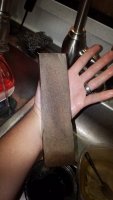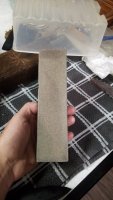- Thread starter
- #21
They've done about 8 hours soaking, iim out of simple green now.Looks like a gouge from sharpening small pointed tools or fishing hooks but could be wrong. You need to get these soaking in some Simple Green to remove some of the dried on oil, that will give a better look at the surface of the stone which will make identifying the stone and any features easier.

